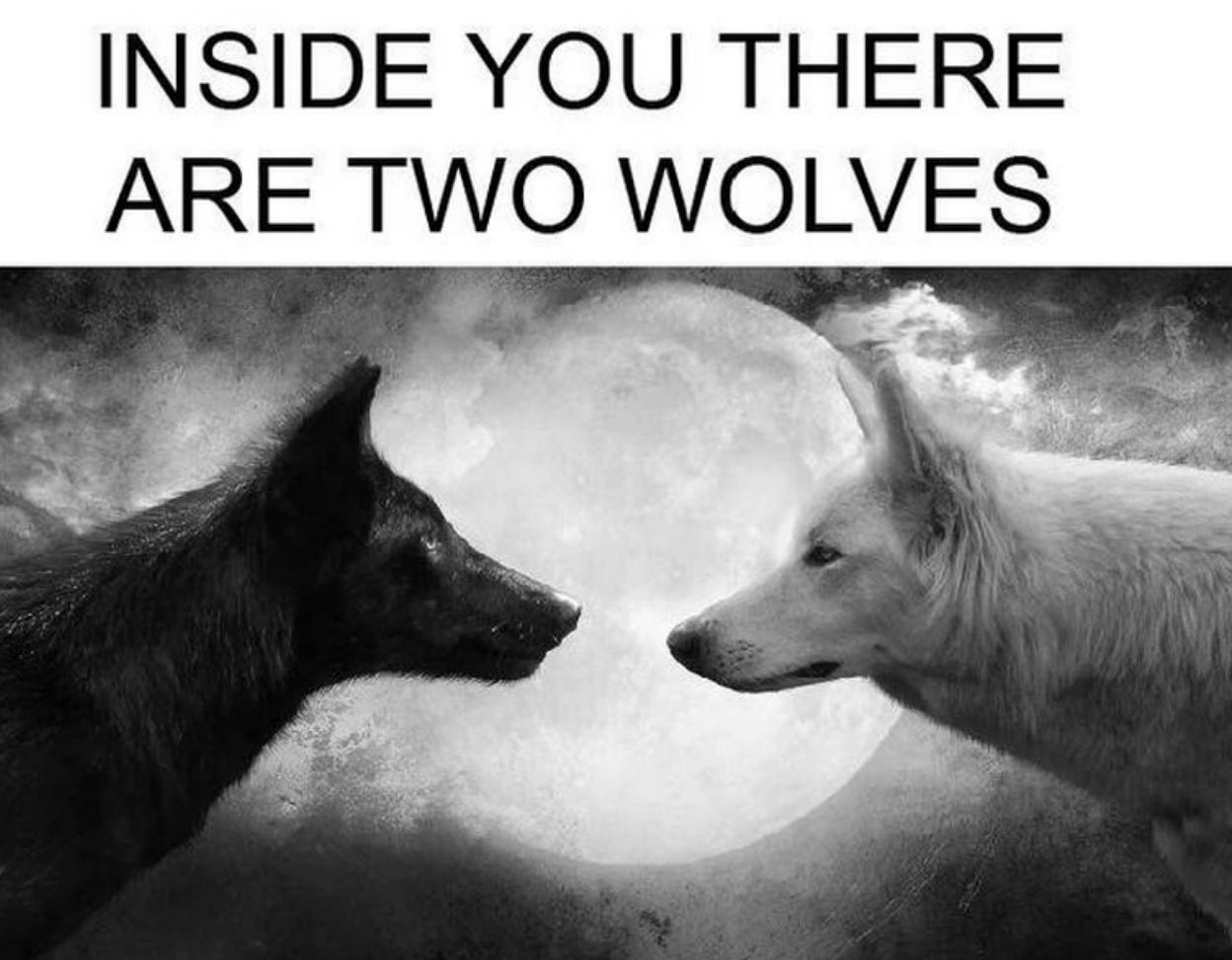Prepping Factions is Easy, Actually
All factions have two wolves inside them.
Factions are daunting to run, and they’re easy to mess up.
As a new GM, I often ran factions like invisible forces in the background, secretly manipulating the power struggle between these factions as the story progressed. But I think that’s the wrong approach. I want the factions in my games to be interactable, for the players to have an impact on them, and for them to have an impact on my players.
Similar to prepping NPCs, if you look for advice online, you’ll find a long list of things to prep, like a symbol, a color scheme, a hierarchy, a structure of leadership, how the leader is chosen, a method of communication, a history of the faction, and an active goal.
But none of that is essential.
In this article, I’ll spell out the basics: 3 steps is all you need, and it’s plenty. Everything else is just window dressing, extra flavor and lore to be added as necessary (or when you have time).
This article is a spiritual successor to my article about Prepping Three-Dimensional NPCs. If you’ve read that article, this one will feel like a natural extension of those principles.
I’m Colin, and I’m a professional video game designer. This is Drolleries, where I write about d&d, ttrpgs, and game design.
1. Shared Belief
The most important part of a faction is the worldview that they share. This is what lets the players understand the faction and manipulate them. Without a strong shared belief, a faction is just… a friend group.
The stronger the belief, the better the faction in my opinion.
The elves believe that humans are shortsighted, selfish, and warmongering, which is why they must protect their wode from the humans at all costs. When humans try to cut down the wode to build roads and churches, the elves are prepared to go to war to protect their land. The reason they stick together is because their worldview is so strong.
But if the blacksmith’s guild only shared belief is that blacksmithing is cool, I don’t think that makes them a good candidate as a faction to worry about.
However, maybe the blacksmith’s guild shares a belief that the weapons they forge should not be used in the Baron’s constant wars against the elves and orcs. This would give them a significant impact on the world, and more importantly, give the players a meaningful way to manipulate them. Knowing that the blacksmith’s guild dislikes the Baron, the players can ask them for help, urge them to take action, or otherwise negotiate with them.
2. An NPC to Represent Them
You need an NPC to personify the faction’s beliefs. It’s the only interesting way to convey details about the faction (without a boring lore dump that your players won’t remember anyways).
This NPC is the player’s point of contact with the faction. It’s often the faction’s leader, but it doesn’t have to be.
The same advice about prepping NPCs applies — don’t try to make them three-dimensional at first. All this NPC needs to do is to represent the faction’s strong belief.
3. Internal Opposition as Another NPC
Just like with writing three-dimensional NPCs, to make a three-dimensional faction, introduce some kind of twist or surprise that goes against what the players already know about them.
Take the faction’s core belief, and introduce another NPC who either disagrees with this belief, or disagrees on some current course of action related to it. This puts them in conflict with the NPC you already introduced, which means that the players have some levers over the faction based on how they interact with these NPCs. If they kill one, then the other takes power. If they get into a shouting match with one, will that increase or decrease that leader’s popularity within the faction?
So maybe the elf leading the minority bloc on the council believes that they should sign a treaty with the humans instead of killing them. Or maybe the opposition leader of the blacksmith’s guild wants to start selling to the Baron again because it’s good for business.
Here’s a longer example from my years-long d&d game.
The Black Tusk orcs live in Dewyll Forest and are constantly under attack from the nearby humans, who pose an existential threat to their tribe and their forest.
The Black Tusk are currently led by Karzug Knightslayer. Karzug is a massive old man, strong and wise, but his glory days are behind him. Having seen many wars, the preservation of his tribe is paramount to him now. Kratos from God of War 2018 vibes.
The opposition is led by Dieter, who is young, angry, and foolish. Dieter hates the humans with a fiery passion and believes Karzug has gone soft. He wishes to lead the Black Tusk to wage war on the human villages to take back the ancestral lands they owned hundreds of years ago and expand their tribe.
In order to become the new leader, Dieter must defeat Karzug in single combat to the death. But Dieter is too weak, and knows he would lose. If the players kill Karzug or otherwise injure him, Dieter takes his place as leader and wages war against the humans. But the players can also learn about Dieter, and decide to unite with Karzug to prevent him from coming to power.
Optional: An Active Goal
I don’t think all factions need an active goal. Many organizations are just trying to preserve the status quo.
The elves want to keep their wode safe and keep to themselves. The orcs want to stop all trespassers through their territory. The Duke wants to stay in power.
However, villainous do need an active goal because something needs to happen if the players fail to act.
The cult is trying to find and summon an ancient demon. The dark elves are kidnapping villagers and turning them into spider-people.
It’s best if these goals can be accomplished in steps, so the GM can raise the stakes if the players are taking too long or pursue other leads. Maybe the cult summons some minor demons first that terrorize nearby villages. Maybe the dark elves kidnap NPCs the players know, and with each idle moment, their transformation becomes more gruesome and horrible.
Even if the villainous faction is trying to preserve the status quo, they still need active goals, they can’t just be sitting on their throne waiting to get their ass whooped. They need to be doing something to put them in conflict with the heroes, and usually their cruel plan is what makes them villainous.
The vampire lord comes down from his castle once a week to take a young woman as his consort. The Pale King is collecting ancient magical artifacts to grow more powerful. The Church is hunting down the heretic rebels who refuse to bend the knee to the Pale King.




Great article. Thanks for sharing.
Thanks for this!